Author Archives: Ajitesh Kumar
8 Key Steps to Follow When Solving A Machine Learning Problem

This article represents some of the key steps one could take in order to create most effective model to solve a given machine learning problem, using different machine learning algorithms. Please feel free to comment/suggest if I missed to mention one or more important points. Also, sorry for the typos. 8 Key Steps for Solving A Machine Learning Problem Gather the data set: This is one of the most important step where the objective is to as much large volume of data set as possible. Given that features have been selected appropriately, large data set helps to minimize the training data set error and also, enable cross-validation and training data set error …
Machine Learning – How to Debug Learning Algorithm for Regression Model

This article represents some of the key reasons for larger prediction error while working with regression models and, what one could do to solve the prediction error. Below mentioned techniques could be used for both, linear and logistic regression models. As a matter of fact, below arguments could also be used to debug an artificial neural network. In place of features, what is considered is number of hidden layers and units. Please feel free to comment/suggest if I missed to mention one or more important points. Also, sorry for the typos. Following are the key points described later in this article: Key Reasons for Larger Prediction Error Key Techniques to …
Machine Learning – How to Diagnose Underfitting/Overfitting of Learning Algorithm
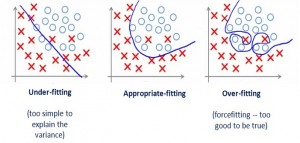
This article represents technique that could be used to identify whether the Learning Algorithm is suffering from high bias (under-fitting) or high variance (over-fitting) problem. Please feel free to comment/suggest if I missed to mention one or more important points. Also, sorry for the typos. Following are the key problems related with learning algorithm that are described later in this article: Under-fitting Problem Over-fitting Problem Diagnose Under-fitting & Over-fitting Problem of Learning Algorithm The challenge is to identify whether the learning algorithm is having one of the following: High bias or under-fitting: At times, our model is represented using polynomial equation of relatively lower degree, although a higher degree of …
Machine Learning – 7 Steps to Train a Neural Network
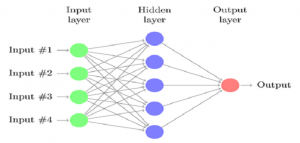
This article represents some of the key steps required to train a neural network. Please feel free to comment/suggest if I missed to mention one or more important points. Also, sorry for the typos. Key Steps for Training a Neural Network Following are 7 key steps for training a neural network. Pick a neural network architecture. This implies that you shall be pondering primarily upon the connectivity patterns of the neural network including some of the following aspects: Number of input nodes: The way to identify number of input nodes is identify the number of features. Number of hidden layers: The default is to use the single or one hidden …
Data Science – 8 Steps to Multiple Regression Analysis
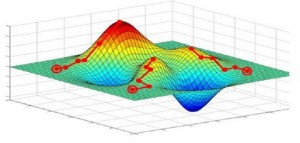
This article represents a list of steps and related details that one would want to follow when doing multiple regression analysis. Please feel free to comment/suggest if I missed to mention one or more important points. Also, sorry for the typos. Following are the key points described later in this article: 8 Steps to Multiple Regression Analysis Techniques used in Multiple regression analysis 8 Steps to Multiple Regression Analysis Following is a list of 7 steps that could be used to perform multiple regression analysis Identify a list of potential variables/features; Both independent (predictor) and dependent (response) Gather data on the variables Check the relationship between each predictor variable …
Big Data – Top Education Resources from MIT

This article represents information on Big Data initiative from MIT (Massachusetts Institute of Technology) including bookmarks on lecture notes related machine learning courses and also, machine learning video channel from MIT on Youtube. Please feel free to comment/suggest if I missed to mention one or more important points. Also, sorry for the typos. Following are the key points described later in this article: MIT CSAIL Big Data Initiative Machine Learning Lecture Notes & Videos MIT CSAIL Big Data Initiative MIT has a website dedicated to Big Data initiative from MIT CSAIL (Computer Science and Artificial Intelligence Laboratory). Following pages are worth visits to understand ongoing research and listen/view talks …
Weekly Roundup – Machine Learning & Statistics Bookmarks – 02 Feb 2015
This article represents links to some of cool pages on machine learning & statistics that I thought worth sharing. Please feel free to comment/suggest any other webpages that found to be good. Sorry for the typos. Machine Learning & Statistics Bookmarks Andrew NG: One starting to learn machine learning is sure to come across course, paper, or a web page related with Andrew NG, an Associate Professor at Stanford; Chief Scientist of Baidu; and Chairman and Co-Founder of Coursera. Some of the pages sighting his work are following: Courses Publications Research Andrew W. Moore: Great set of tutorials by Andrew D. More, who is Dean of the School of Computer …
Machine Learning – 9 Most Common Usecases for Higher Business Growth
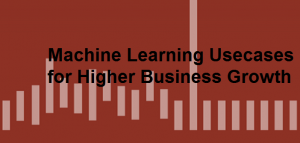
This article represents some of the most common use cases of machine learning algorithms which has been found to impact business growth (in terms of revenues) in a positive manner. These usecases could be most commonly seen with all businesses which are running some or the other form of ecommerce site to support one or more aspects of their business. I have tried and provide information regarding which algorithm (or class of algorithm) could be used to come up with a solution for these usecases. Please feel free to comment/suggest if I missed to mention one or more important points. Also, sorry for the typos. Following are different areas, at …
Top 4 Machine Learning Usecases for Energy Forecasting
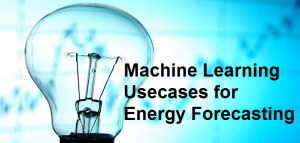
This article represents top 4 machine learning usecases for energy forecasting. Please feel free to comment/suggest if I missed to mention one or more important points. Also, sorry for the typos. Machine Learning Usecases for Energy Forecasting Following are different usecases in relation with energy management where machine learning could be used for probabilistic energy forecasting. For those who are new to probabilistic forecasting, here is the definition from Wikipedia: Probabilistic forecasting summarises what is known, or opinions about, future events. In contrast to a single-valued forecasts (such as forecasting that the maximum temperature at given site on a given day will be 23 degrees Celsius or that the result …
Big Data – Free Hadoop Online Training Course from MapR
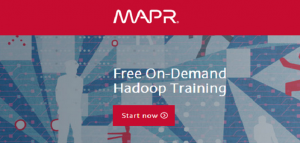
This article represents quick information on free Hadoop online on-demand training that has been announced yesterday by MapR Technologies, the Hadoop distribution specialist. I took Hadoop Essentials course and I must say that I liked the training session. The downside of these training sessions is that you would soon hit MapR related technologies in relation with MapReduce, HBase, HDFS. However, that said, its worth giving a shot. Please feel free to comment/suggest if I missed to mention one or more important points. Also, sorry for the typos. Training Courses for Hadoop Developer, Hadoop Administrator & Data Analyst The training includes topics related with a range of Hadoop technologies for …
Machine Learning Usecases for Pinterest.com & related Kosei Acquisition

This article represents thoughts on recent acquisition of Kosei, a commerce recommendation system, by Pinterest.com. Please feel free to comment/suggest if I missed to mention one or more important points. Also, sorry for the typos. Following are the key points described later in this article: How could Machine Learning help Pinterest fuel its overall growth? How could Kosei help Pinterest.com? How could Machine Learning help Pinterest fuel its overall growth? Yet another acquisiton in the space of machine learning, Pinterest.com acquires Kosei to achieve some of the following objective: Better ad targeting for greater mometization from ad clicks. This looks to be a case of identifying users clusters based …
Data Science – List of Common Machine Learning Problems with Examples

This article represents quick examples for 5 different classes of machine learning problems/tasks. Please feel free to comment/suggest if I missed to mention one or more important points. Also, sorry for the typos. Following is a set of 5 key machine learning problems/tasks whose examples have been listed later in this article: Regression Classification Clustering Association Rules Artificial Neural Networks Examples – Regression Models Real Estate – Housing price estimation Financial – Stock price estimation Insurance – Estimate medical care expenses Sales & Marketing – Sales vs Ad spend Company growth estimation Examples – Classification Models Following are four different algorithms whose examples have been listed below: Naive …
Cheat Sheet – 10 Machine Learning Algorithms & R Commands
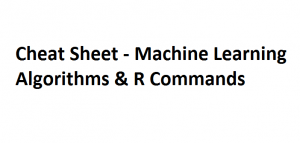
This article lists down 10 popular machine learning algorithms and related R commands (& package information) that could be used to create respective models. The objective is to represent a quick reference page for beginners/intermediate level R programmers who working on machine learning related problems. Please feel free to comment/suggest if I missed to mention one or more important points. Also, sorry for the typos. Following are the different ML algorithms included in this article: Linear regression Logistic Regression K-Means Clustering K-Nearest Neighbors (KNN) Classification Naive Bayes Classification Decison Trees Support Vector Machine (SVM) Artifical Neural Network (ANN) Apriori AdaBoost Cheat Sheet – ML Algorithms & R Commands Linear regression: …
Top 4 Javascript Frameworks to Watch out in 2015
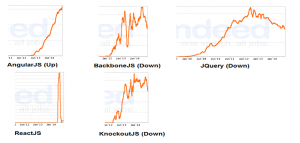
This article presents analytics on popular Javascript frameworks and call out top 4 javascript frameworks (event-handling) one should watch out in 2015. From the analysis below, AngularJS Rocks!!! Please feel free to comment/suggest if I missed to mention one or more important points. Also, sorry for the typos. Following are the top 7 Javascript frameworks that are considered in this analysis: AngularJS JQuery BackboneJS KnockoutJS ReactJS MeteorJS EmberJS The analytics presents data based on trends captured from Google Trends and Indeed.com job trends. Please feel free to suggest any javascript frameworks that I may have missed. From the analysis below, following are top 4 javascript frameworks that you may want to watch out …
ReactJS – Component-oriented UI Design Explained with Calculator Example
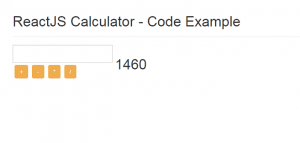
This article represents high level concepts with code examples used to create a trivial calculator using ReactJS. Please feel free to comment/suggest if I missed to mention one or more important points. Also, sorry for the typos. Following are the key points described later in this article: Design & Analysis – ReactJS Calculator Code Sample – ReactJS Calculator Design & Analysis – ReactJS Calculator Calculator consists of three components, one (Operation) of which is reusable component. Following are these components: InputField: This represents textfield which allows uses to enter the number Operation: This component represents operation such as addtion (+), subtraction (-), multiplication (*), division (/) in the example …
Sublime ReactJS Bootstrap HelloWorld Template for Quickstart
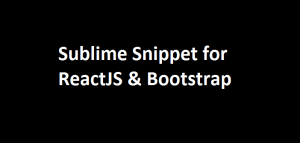
This article represents Sublime Snippet for quickstarting your ReactJS learning sessions with help of ReactJS-Bootstrap code for HelloWorld. It comes very handy for me and thought to share with you. Please feel free to comment/suggest if I missed to mention one or more important points. Also, sorry for the typos. Code Sample – Sublime Snippet for ReactJS Bootstrap Hello World Template In your sublime editor, go to Tools > New Snippet, paste the code below and save. Open a new file, save it as html file, write “rjshello” and press CTRL+Space bar. That is it. You would get the ReactJS Hello World code for quickstarting your project. The code …
I found it very helpful. However the differences are not too understandable for me